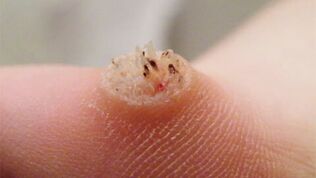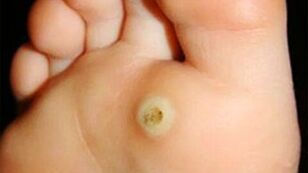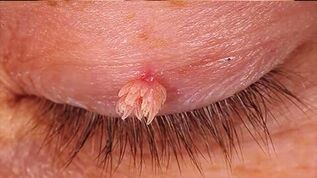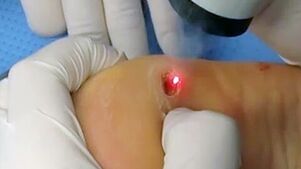
Warts are beautiful, benign tumors that appear on the skin when infected with human papillomavirus. The virus enters the upper layer of the epidermis, causing its cells to proliferate, resulting in warts of various shapes, sizes, and colors.
Human papillomavirus infects about 80% of people on the planet, and not every patient knows his diagnosis, because HPV is asymptomatic in most cases.
Types of warts
The type of wart depends on the location, color, size, shape, and pathogen type of the body.
Common or common warts
Most commonly, their appearance does not depend on the age or gender of the patient. They are located in the hand, between the fingers, and on the back of the palm (less on the palm itself). Coarse warts are irregular or round, and because of their flesh-red color, they are usually less noticeable on the skin. The size ranges from 1 to 3 mm. As the infection time increases and without treatment, tumors may appear in the affected area.
Flat warts
Tumors of this species are more common in children and adolescents, so their name is juvenile warts. They are fleshy or light brown nodules, oval or round, with a smooth surface, slightly higher than the skin. Mainly distributed on the skin of the face, neck, arms and upper body.

Plantar warts
This wart only appears on the skin of the feet, which is why it gets its name. It is a rough growth with a keratinized skin layer or a group of such growths. The skin around the wart loses its natural color and turns grayish yellow. The surface of the wart hardens and begins to squeeze the surrounding healthy tissue, causing severe discomfort.
Warts
The uniqueness of this species lies in the narrow joints with the skin surface, the so-called "legs". The hanging warts can be rectangular, round or irregular, pink or reddish. These warts are located on women's breasts, neck, face, and underarms. Usually, the appearance of many hanging warts heralds a sharp decline in the human immune status.
Senile warts
This type of wart is more likely to affect the skin of the elderly. They are also called seborrheic warts or keratomas. They develop due to age-related changes and deterioration of epidermal cell metabolism, and usually trap the upper part of the hair follicle. The keratomas are round, well-defined, and located on the scalp or face. The size varies from a few millimeters to 4-5 cm.

Genital warts
Genital warts or contusions are the most unpleasant and painful neoplasms. Their pathogens are human papillomavirus types 6 and 11. Condyloma acuminata can affect the skin near the mucous membranes: lips and eyelids; in the genital area, urethra, anus.
Compared with cauliflower or celosia, genital warts usually have a nodular growth structure. The dy projections are connected to the skin surface through tiny “legs”. Due to the location in the body area prone to mechanical irritation, the genital warts and adjacent tissues are highly damaged, and the infection process occurs and develops into exudative or purulent secretions.
Causes of warts
The increased activity of human papillomavirus in the body causes the appearance of warts. Infection occurs through contact and daily life: touching, shaking hands, sharing objects, and failing to observe personal hygiene rules in public places. Genital warts are transmitted sexually.
The virus enters its active form if the following factors occur:
- Severe or chronic stress;
- transferred infectious diseases;
- Reduced immunity;
- Hormonal disorders, abnormal metabolism;
- Excessive sweating;
- Skin wounds and minor injuries;
- Wear clothes and shoes made of unnatural materials.
If the disease is asymptomatic, it can only be diagnosed by laboratory means.
Adult warts
Papillomas or warts may appear at any age. At the same time, gender does not play a special role-both men and women are susceptible to HPV. At the same time, women are at higher risk of warts, because of their hormone levels, pregnancy and feeding children tend to weaken their immunity. Due to the particularity of the anatomical structure, women are also more likely to develop genital warts, especially genital warts, which will increase the risk of cervical cancer.
In men, warts appear only when the immunity is drastically reduced, but this rarely occurs in strong sexes. At the same time, men rarely carry HPV 16 and 18 viruses, which instigate the development of tumor diseases.
Child warts
Warts are very common in children and adolescents, because their immunity is not fully developed, so they are very susceptible to papillomavirus. Usually, children in kindergartens and schools are in a stressful situation, which has a negative impact on the body's defense capabilities, which plays an important role. In addition to the infection method of family contact, intrauterine infection of the mother is also possible.
In most cases, children will develop vulgar, juvenile or plantar warts, and juvenile warts will disappear on their own when they are 14 to 18.

Wart treatment
When treating warts, it should be understood that it is impossible to completely eliminate the pathogen-human papillomavirus from the human body. Once in the body, it will always exist, but healthy immunity can keep it under control and minimize the performance of important activities.
The fact that warts appear indicates that the immune status of the body has decreased. Therefore, HPV treatment should include measures to strengthen the immune system. Even if the wart is successfully removed, the body's defense response will be reduced, and the possibility of recurrence is high. However, in people with strong immunity, warts can go away on their own.
The treatment should be selected after a thorough examination by a qualified doctor. Self-medication is unacceptable because laymen cannot distinguish warts from malignant tumors. The problem of removingwartsis also determined by experts-injured tumors can change from benign to malignant.
There are the following methods to eliminate warts.
- Freeze molding (freezing with liquid nitrogen). This method is particularly effective for common warts. Expose the tumor to liquid nitrogen for 10-30 seconds. This method has the advantage of low trauma; it takes 1 to 5 courses to completely remove the warts.
- Laser coagulation (laser removal). Part of the tumor is removed under local anesthesia. At the location of the wart, a groove remained, which disappeared after about a month.
- Electrocoagulation (removed by current). Use high-frequency current through a thin metal ring to remove the wart. This method is characterized by no bleeding and additional tissue disinfection. The tumor tissue remains intact, so it can be sent for histological examination. The operation trace disappeared within a week.
- Surgical removal. This method is only used in extreme cases, when the tumor is too large or grouped into a single mass. Under local anesthesia, use a scalpel to remove the wart like a conventional operation. The removed material was sent for histological examination. Whether there is a scar at the excision site depends on the skill of the surgeon using the suture.
- A chemical attack method using various acids or bases. This method is the most painful, most traumatic and most dangerous because the risk of secondary tissue infection at the exposed site is very high. When deciding to use it, it’s worth remembering that you can only act on the wart itself and not the skin near the wart.
Drugs for treating warts
Local therapy is used to treat warts, but its effectiveness depends on the age of the tumor-the fresher the wart, the more likely it is to be removed, as well as the patient’s immunity.
Before using local therapies, you should consult a dermatologist and conduct tests to determine the nature of the tumor, because exposure to drugs can cause wart cells to degenerate into malignant cells.
Non-traditional ways to deal with warts
Traditional medicine recipe use:
- garlic;
- bow;
- Celandine;
- Euphorbia;
- Wormwood;
- Linseed oil.
After consulting your doctor, traditional medicine is a good supplement to mainstream therapy.
Prevent warts
The best way to prevent warts is to follow personal hygiene rules: wash your hands promptly, use personal manicure accessories, towels, towels and shoes. You should not enter the swimming pool barefoot, share showers, baths and saunas. Similarly, when staying in a hotel, it is worth bringing a disinfectant to treat the bathroom. At the same time, it is necessary to strengthen the immune system and take care of overall health.























